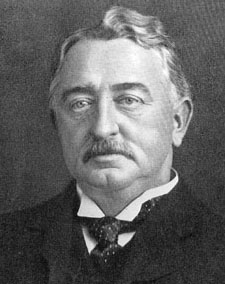Africa and Diamonds

Cecil John Rhodes. Source: NNDB.
Southern Africa is rich in diamond deposits, and the African diamond industry has a rich history. The diamond mining story begins with Cecil Rhodes, who arrived in South Africa in 1870 at the age of 17 years. He purchased diamond claims and proceeded to pump water out of flooded Kimberley mine claims. Barney Barnato arrived in South Africa in 1873 when he was 20 years old. He purchased four claims in the Kimberley mine. As his profits increased, he formed the Barnato Diamond Mining Company. Eventually, Barnato sold his operation to Rhodes for $25 million dollars (that's late 1800 dollars!) and paid with the largest check ever issued at that time. Rhodes went on to form the De Beers Cosolidated Mines, became Prime Minister of Cape Colony and created Rhodesia (now Zimbabwe). Current De Beers operations can be viewed online.
Botswana
Botswana is the third largest producer of diamonds and has immense reserves. De Beers found three world-class kimberlites between 1967-1973. The Orapa pipe is the second largest pipe in the world, producing 5.5 million carats per year. The Jwaneng pipe is under the sands of the Kalahari Desert and produces 10 million carats per year.
Democratic Republic of Congo
After Australia, Democratic Republic of Congo (Zaire) is the second largest producer of diamonds, with 20 million carats in 1995. Only 6% of the diamonds are considered to be of high gemstone quality. Mbuji-Mayi is one of the world's most prolific mines, producing 5 million carats per year.
Namibia
Since 1908, diamonds have been extracted from the sand dunes near Kolmanskop in Namibia. Currently, this location produces 1.3 million carats per year. The diamonds are small but high quality. South Africa gained control of Namibia after World War I and sold the diamond deposits to Consolidated Diamond Mines, then transferred to De Beers in 1929. In 1994, the CDM was reconstituted as Namdeb Diamond Corporation and is now jointly owned by the Namibian government and De Beers.
South Africa

Aerial view of the Koffiefontein diamond mine, South Africa, operated by De Beers. © De Beers. Source: SEED.
South Africa now produces only 15% of the world's diamonds - not enough to provide much leverage over world markets, yet De Beers still controls 80% of world diamond trading. But it can no longer control the market using its own resources, and is therefore evolving to become the dominant company in a traders' cartel, rather than the dominant company in a producers' cartel. It is more vulnerable now than it has been for a century. It must keep the major producers happy on its "upstream" side, and its customers in order on the "downstream" side, whatever that takes. The bottom line is that the diamond market will have to reflect general world supply and general world demand more than it has in the past. Once, De Beers could simply slow production, leaving unwanted diamonds in the ground (just as good as money in the bank), as long as it could control the market to ensure that those unmined diamonds would bring a good price once they were brought to market. Today, the producers (Australia, Botswana, Russia, De Beers, and the Congo) are most unlikely (probably unable) to sacrifice their cash flow from diamond mining, and it is up to De Beers, from its own resources, to do what it can to stabilize diamond prices rather than hold them artificially high.
Other contributors
Other African nations are significant contributors to the world production of diamonds. According to 1996 statistics:
- Angola produces 1.8%
- Ghana 0.7%
- Central African Republic 0.6%
- Guinea 0.5%
- Sierra Leone 0.3%
- Zimbabwe 0.2%.
Clearly, Africa has dominated diamond production during the 20th century, with mining activity centred in Botswana and South Africa and concentrated in the hands of De Beers. But, although Africa is still the centre of the industry, the last decade has seen an expansion of production in Canada and Russia.